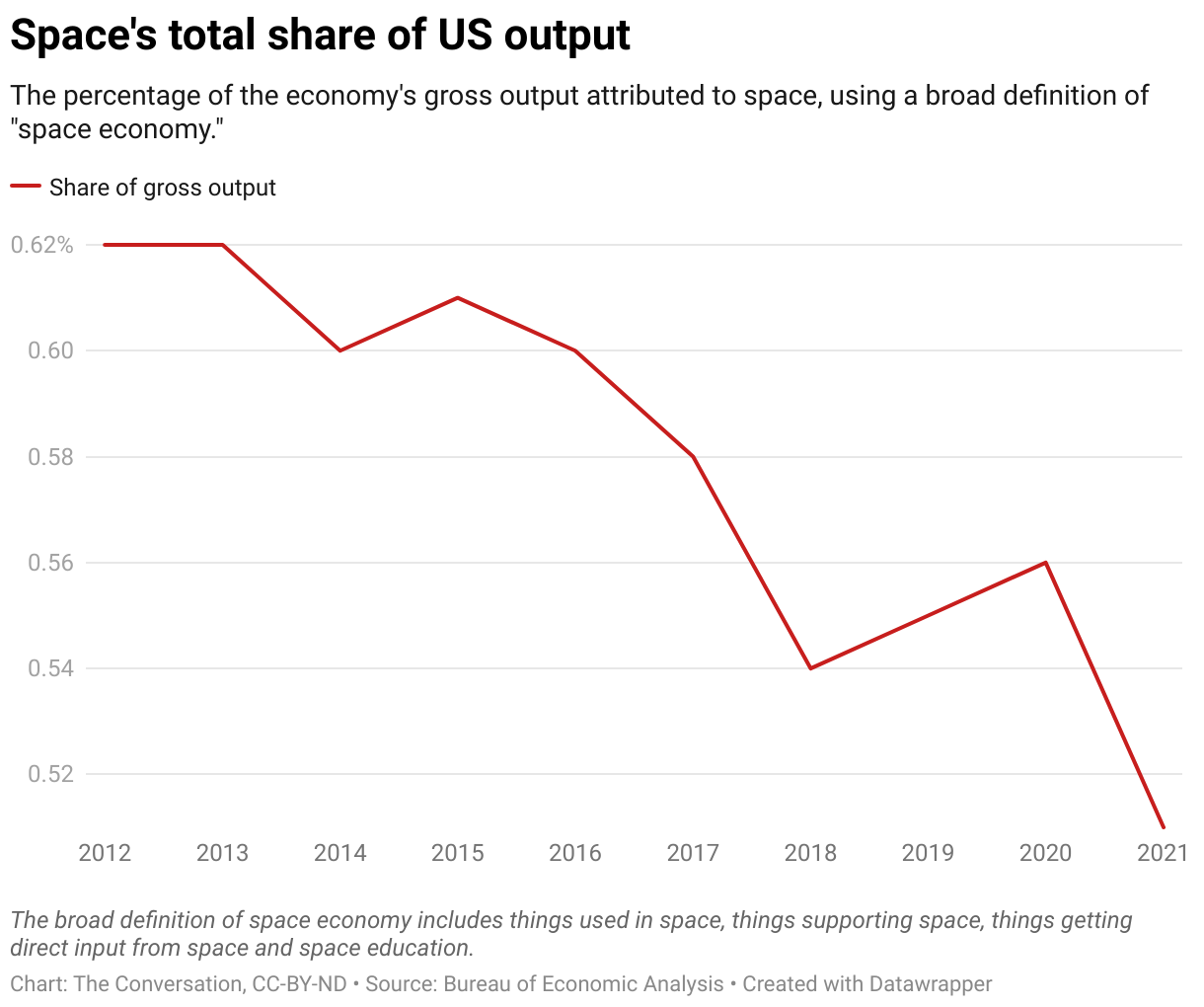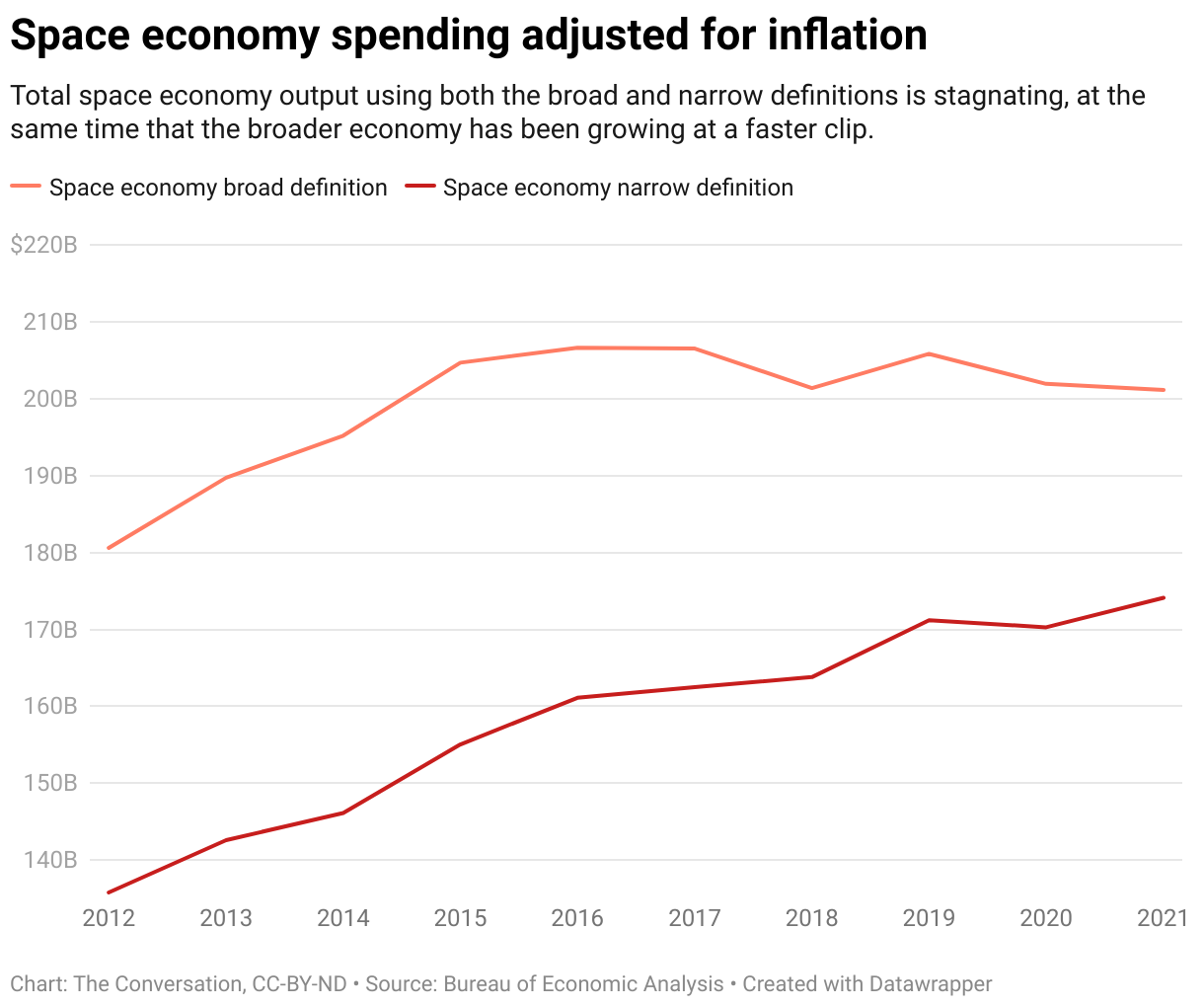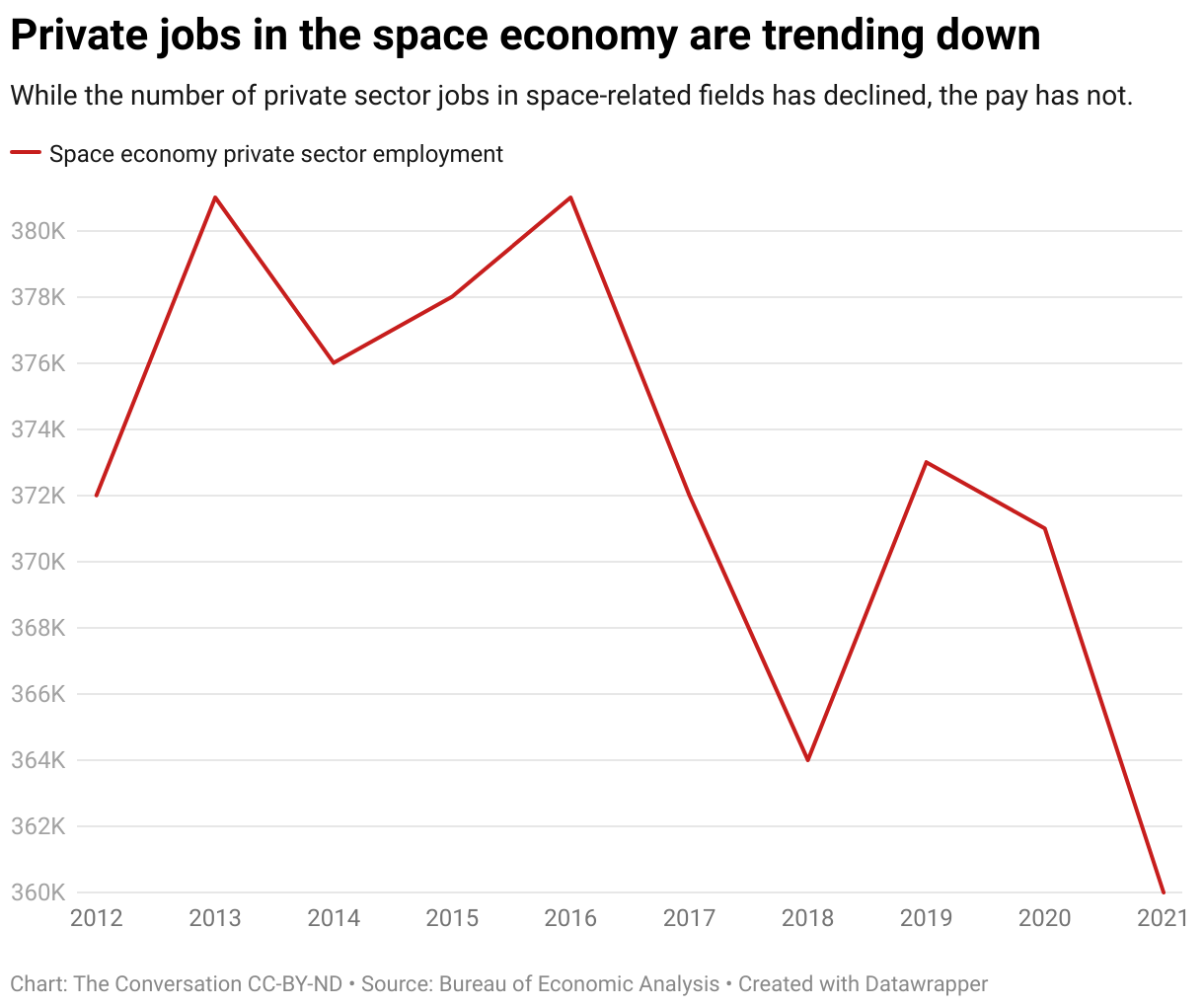
New data reveal US space economy's output is shrinking – an economist explains in 3 charts
Using the broad definition and adjusting for inflation, the relative size of the space economy fell by about one-fifth from 2012 to 2021.

This article was originally published at The Conversation. The publication contributed the article to Space.com's Expert Voices: Op-Ed & Insights.
Jay L. Zagorsky is an economist at Boston University's Questrom School of Business.
The space industry has changed dramatically since the Apollo program put men on the moon in the late 1960s.
Today, over 50 years later, private companies are sending tourists to the edge of space and building lunar landers. NASA is bringing together 27 countries to peacefully explore the moon and beyond, and it is using the James Webb Space Telescope to peer back in time. Private companies are playing a much larger role in space than they ever have before, though NASA and other government interests continue to drive scientific advances.
I'm a macroeconomist who's interested in understanding how these space-related innovations and the growing role of private industry have affected the economy. Recently, the U.S. government started tracking the space economy's size. These data can tell us the size of the space-related industry, whether its outputs come mainly from government or private enterprise, and how they have been growing relative to the economy at large.
Companies like SpaceX, Blue Origin and Virgin Galactic made up over 80% of the U.S. space economy in 2021. The government held a 19% share of space spending, up from 16% in 2012 – mostly thanks to an increase in military spending.
Related: NASA working to get private space stations up and running before ISS retires in 2030
Get the Space.com Newsletter
Breaking space news, the latest updates on rocket launches, skywatching events and more!
Ways to measure the space economy
There are many ways to measure economic success in space.
One way is the economic impact. The U.S. Bureau of Economic Analysis, which tracks the nation's gross domestic product and other indicators, recently began to monitor the space economy and published figures from 2012 to 2021. The Bureau of Economic Analysis calculated the impact of space using both broad and narrow definitions.
The broad definition comprises four parts: Things used in space, like rocket ships; items supporting space travel, like launch pads; things getting direct input from space, like cell phone GPS chips; and space education, like planetariums and college astrophysics departments.
In 2021, the broad definition showed that total space-related sales, or what the government calls gross output, was over US$210 billion, before adjusting for inflation. That number represents about 0.5% of the whole U.S. economy’s total gross output.

The Bureau of Economic Analysis also has a narrow definition that excludes satellite television, satellite radio and space education. The difference in definitions is important because back in 2012 these three categories represented one-quarter of all space spending. However, by 2021, they only represented one-eighth of spending because many people had switched from watching satellite TV to streaming movies and shows over the internet.
Space's share of the economy
A closer look at the data shows that space's share of the U.S. economy is shrinking.
Using the broad definition and adjusting for inflation, the relative size of the space economy fell by about one-fifth from 2012 to 2021. This is because sales of space-related items – everything from rockets to satellite TV – have barely changed since 2015.
Using the narrow definition also shows the space economy is getting relatively smaller. From 2012 to 2021, the space sector’s inflation-adjusted gross output grew on average 3% a year, compared with 5% for the overall economy. This suggests space is not growing as fast as other economic sectors.

Space jobs
The number of jobs created by the space economy has also declined. In 2021, 360,000 people worked full- or part-time space-related jobs in the private sector, down from 372,000 about a decade earlier, according to the Bureau of Economic Analysis.

The Bureau of Economic Analysis could not track all space-related government jobs since spy agencies and parts of the military don't provide much information. Nevertheless, it has tracked some since 2018. The military's Space Force, which is the smallest branch, adds about 9,000 workers. NASA has about 18,000 employees, which is half of its 1960s peak.
Combining these government workers plus all private workers results in just under 400,000 people. To give some perspective, Amazon's U.S. workforce is over twice as big and Walmart's is four times bigger than reported U.S. space-related employment.
Growing competition in space
The U.S. has long dominated the space economy, especially in terms of government spending.
The U.S. government spent a little more than $40 billion in 2017, compared with about $3.5 billion spent by Japan and less than $2 billion by Russia.
Moreover, most of the top private space companies are based in the U.S., led by Boeing, SpaceX and Raytheon, which gives the U.S. a leg up in continuing to play a leading role with the rockets, satellites and other stuff needed to operate in space.
The U.S. also published more than twice the amount of space research in 2017 as its next nearest rival – China.
But China is catching up and has narrowed the gap in recent years as top Chinese officials decided success in space is a national priority. Their goal is reportedly to surpass the U.S. as the dominant space power by 2045. China recently put a large space station called the Tiangong into orbit and aims to put people on the moon.
China's not the only one joining the 21st century space race. India is expanding its space economy rapidly, with 140 space-tech startups. India launched a rocket on July 14, 2023, designed to put a lander and rover on the moon. And the European Space Agency’s Euclid spacecraft plans to map parts of the universe to study dark matter. The ESA released the craft's first test images at the end of July 2023.
The U.S. has a strong foothold in space. But whether it can maintain its lead – as the space race moves into a new frontier of space mining and missions to Mars – remains to be seen.
Join our Space Forums to keep talking space on the latest missions, night sky and more! And if you have a news tip, correction or comment, let us know at: community@space.com.

I teach at Boston University's Questrom School of Business. From 1988 to the present my teaching has spanned a wide range of levels from senior executives taking intensive classes to high school students encountering economic theories for the first time. I have taught giant lectures of over 450 students, classes of fifty, and small seminars with fewer than ten people.
From 1995 to 2018 I held the position of Research Scientist at The Ohio State University, where I collected data as part of the National Longitudinal Surveys on income, wealth, and life experiences of thousands of Americans. My personal finance research has been widely quoted in the media and has been highlighted in the Wall Street Journal, USA Today, Fox News, Good Morning America, Scientific American and numerous other news outlets.
-
Atlan0001 Humans cost too much in the space frontier . . . better machine technology in space than humans! The Big Lie since without human growth momentum to the space frontier the cost of human growth / human stagnation / human shrinkage on Earth is growing untenable. The cost of humans on Earth, period, is growing insupportable. The path to dark ages is not too many humans but too few . . . population die off, population infertility, population energy, loss of mass genius -- which Will Durant ('The Story of Civilization') said always comes from the ranks of the common people, the peasant population, the would-be frontier population, and never from the elites rigidly married to a steady-state elite status quo (the cost of which inexorably rises to infinity (amply exampled in Aldous Huxley's, 'A Brave New World')).Reply
So, we have an increasingly closed system of Earth only as the space economy shrinks (as permissible human space participation over time shrinks and costs more and more , , , and the cost of humans, and human civilization (energetic infrastructure) on Earth, period, is increasingly -- inexorably -- untenably rising.
Hawking's 1,000 year prophesy to human downfall without birth to space frontier from Earth was wildly, outlandishly, optimistic as to time. We need to begin transferring industry and economy to space fronter, building in space -- especially spin-gravity stations, tooling up to space colony facilitation for life -- now, not later (and later, and later, and later. and.... costing too much; too far too much; too far, far, too much; to infinity), Things won't hold. Won't sit still. Won't wait til later, "when costs go down" (hahahaha).
What of the Old-World Earth while things are moving, gaining momentum, in and to the New World of Space Age Frontier? You'd have to be blind to history and physics to not see that then the Old World -- the homeland world of Earth -- would itself be a New World Frontier from being a big part of it! In 1512CE, Sir Thomas More wrote 'Utopia' as a nostalgia for the Middle Ages because he hated what the opening systemic New Frontier Renaissance Age (to maritime East and West) was doing to his elite human feudal fiefdom of Old-World Europe. -
Phillip Huggan Increasing the mechanical force used for manufacturing in space will require linear induction motors. Humanoid robotics or numerous drones networked aren't allowed. Single axis of motion crystalline nanotech will be a while. Manufacturing in space can be automated with iron and copper induction rails. This permits matter to be moved around without much friction which wears many other mass movement methods. Ideally the linear induction stage resembles "Cool Runnings" as it is shuttled mostly without friction contact, perhaps carrying some ore, an ingot, or magnet in construct.Reply
Electricity will be needed. It is unlikely Lunar dust will permit magnets to reliably work. Right now Silicon Valley and Seattle are missing iron working processes such as cold rolling (of iron magnet layers). For asteroids, Jupiter trojans and the Saturn system, you'll need a simple way to move mass around. Iron will be at the asteroids maybe Cobalt once Saturn is developed. Smelting is a tougher induction rail environment than is laser sintering and UHV 3d printing processes. -
Atlan0001 Gravity will be pure gold, pure golden commodity, for life in space. But, for most industrial processes, most industrial needs as such, gravity always must be fought and is one of the costliest liabilities for industry on Earth. Having the two equal but opposites available, together at hand where and when needed and wanted, in space will be the best of two worlds . . . profitably, the best of the two environments.Reply
And as many knowing physicists and engineers have said, you can construct very large-dimensioned structures either impossible of construction or so costly of construction, or, yet, unnecessary of construction, as to be unfeasible on Earth. Regarding purities in industrial processes, you can make it all better and far less costly in space once you've done the tooling for it.
Energy is costly on Earth, regardless of source. It is source free of charge at all times in space (solar).
You can manipulate masses, energies, environment, space itself, for whatever industrial or life need or want, with gravity or essentially no gravity (micro-gravity), incredibly cheaper in space, once tooled for it, unlike anything than can be done on Earth. And with that external environment, no concerns about heat pollution, or most any other form of external polluting, -
Phillip Huggan The dimensional scale is important. For power we can eventually use tidal Enceladus. It will have rocket fuel. And we can charge stuff at Earth orbit w/ solar. Manufacturing in space requires industrial environment equipment not clean room stuff. Even ball bearing induction stages are too much friction for me; electric drives tend to be 2/3s as powerful as are permanent magnet ones; the latter need about 1mm clearance stage to rail. Any smaller is friction and wear. Bigger will be harder as power is only whatever we bring from Earth orbit. That is the starting point for space manufacturing without Saturn help: we need enough electricity to move things around with an induction motor and its self-induction loss. Jupiter's trojans won't easily be w/out radiation. That leaves manufacturing manned at Cis-Lunar orbits, Demios, or the (belt) asteroids. The former is ready to have induction motors move mass around but there is no in situ iron. And it is a dangerous satellite that houses teleoperated ore refining and induction motors.Reply
Two possible starting strategies: 1) Lift equipment up to Cis-Lunar to prepare a Demios warehouse on the way to asteroids. Risky stations w/out shielding.
2) Prepare a direct trip to a Si or Fe asteroid. It isn't clear whether bringing iron ore back to Demios is cost effective or whether you need the complete factory right on an asteroid.
We need both manned and induction motors just to avoid astronaut overtime hrs. -
Phillip Huggan Demios warehouses would contend with bringing partially processed ore, crushed hi-grade rocks, or Ayer's rock, from the Belt. These processes could be unmanned or partially manned at the asteroid end may require linear motors. Assumed there is already ion making at the Belt as a shattered liquid sheet of Si or Fe IDK quality. It is an incremental path.Reply
Going right from an armoured L-Point space station and induction motor stages moving around dozens of Newtons of pure metals, right to an asteroid is harder as the L-station is vulnerable being a real manned factory and also a full space station at the Belt has many drawbacks. But you might optimize your in situ of linear motors better rather than cheating with permanent magnets from Earth. A Demios warehouse is maybe 2035 or a powered armoured manufacturing L-station is 2035. Surely without Starship and Falcon 9 these projects would cost 4x more.









